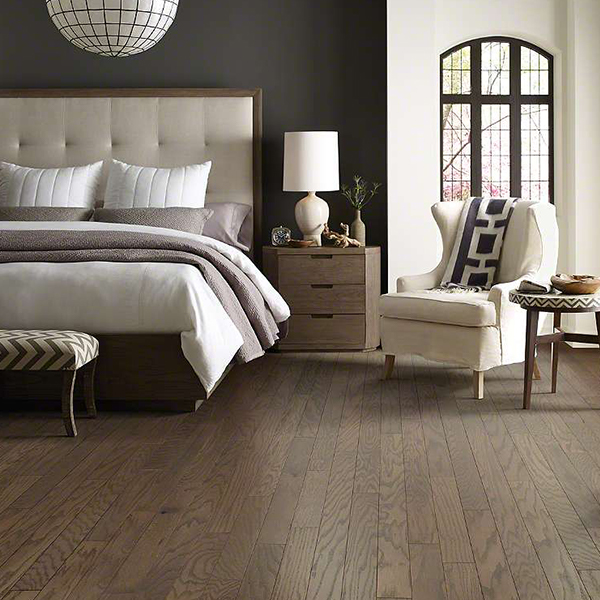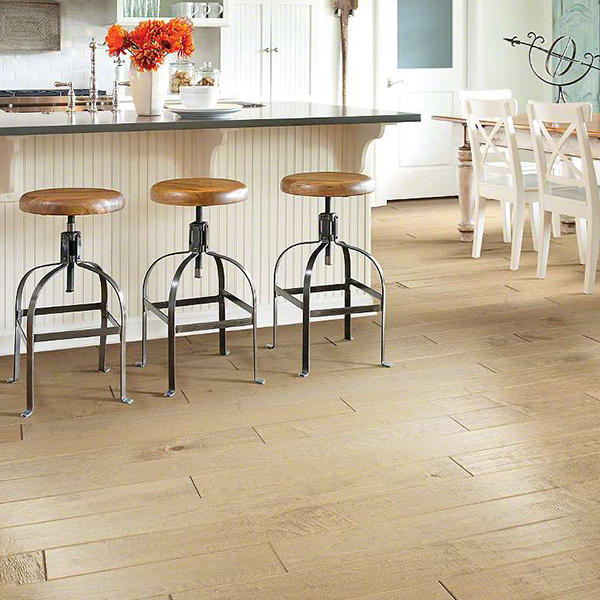Rich and inviting, hardwood makes a distinctive statement. Because of a great range of natural variations—from boards with extreme character, graining, and color variation to those that are evenly colored and consistent—lustrous hardwood can create a uniquely beautiful floor. Your kind of floor – warm, stylish, and original.
Hardwood floors are beautiful and long-lasting. They make an elegant choice for nearly any room in your home. When choosing hardwood, the color, character, and construction type are the important factors to consider.
- Color: the color of hardwood floors ranges from quite light to intensely dark—and everything in between. Lighter floors tend to work well in contemporary settings, and darker floors are elegant at home in more traditional rooms. Choosing, however, is essentially a matter of preference.
- Character: naturally present in hardwood, grain variations help determine a wood’s “personality.” Dramatic grain suggests a rustic feeling. Historically, moderate grain variations are associated with the traditional, and hardwood with very little graining has a sleek, contemporary look.
- Construction: there are two basic choices—solid or engineered. Solid planks are created from a single piece of wood and make a handsome floor that lasts for years. Engineered planks are made from several layers of wood (with a core of plywood or HDF) and are designed to withstand higher levels of humidity. This means they can go in some rooms where solid floors can’t.
Note that there are many differences in finishes—gloss or luster level, scraping degree and technique, wire-brushing, etc. Ask our sales staff to show you samples!
For cleaning, make sure you:
- Use a damp cloth to blot spills and spots as soon as they happen. For tough spots, such as oil, paint, markers, lipstick, ink, tar, or cigarette marks, use acetone/nail polish remover on a clean white cloth, then wipe with a damp cloth. Never allow liquids to stand on your floor.
- Sweep, dust, or vacuum the floor regularly with the hard floor attachment (not the beater bar) to prevent accumulation of dirt or grit that can scratch or dull the floor finish.
- Occasionally wipe the floor with a damp mop or cloth.
While cleaning is easy, there are a few things to avoid:
- Don’t use oil-based, wax, polish, or strong ammoniated or abrasive cleaners.
- Don’t use steel wool or scouring powder.
- Don’t wash or wet-mop the floor with soap, water, oil-soap detergent, or any other liquid cleaning material. This could cause swelling, warping, delamination, and joint-line separation, and void the warranty.
- Don’t use any type of buffing machine.
Other routine care instructions:
- For spots such as candle wax or chewing gum, harden the spot with ice and then gently scrape with a plastic scraper, such as a credit card. Be careful not to scratch the flooring surface. Wipe clean with a damp cloth.
- Use protective mats: high-quality entry and exit mats will help collect the dirt, sand, grit, and other substances such as oil, asphalt, or driveway sealer that can otherwise be tracked onto your flooring. Do not use rubber- or foam-backed plastic mats as they may discolor the flooring. To prevent slippage, use an approved vinyl rug underlayment.
- Use floor protectors on furniture: use floor protectors and wide-load-bearing leg bases/rollers to minimize indentations and scratches from heavy objects. As a rule, the heavier the object, the wider the floor protector should be.
- Maintain relative humidity level: maintain a normal indoor relative humidity level between 45 and 65 percent throughout the year to minimize the natural expansion and contraction of wood.
- Heating Season (Dry): A humidifier is recommended to prevent excess shrinkage due to low humidity levels. Wood stove and electric heat tend to create very dry conditions.
- Non Heating Season (Wet): An air conditioner, dehumidifier or periodically turning on your heating system can maintain humidity during the summer months. Avoid excessive exposure to water during periods of inclement weather.
- Avoid sharp objects: while your Shaw Hardwood floor is one of the most wear-resistant floors on the market, sharp or pointed objects can damage it nonetheless.
- Watch your feet: don’t walk on your flooring with stiletto-style heels, spiked golf shoes, or cleats. They may cause indentations in your flooring.
- Watch your pet’s feet: keep your pet’s nails trimmed to keep them from scratching your floor.
- Rearrange your rugs and furniture: periodically rearranging your area rugs and furniture will allow the flooring to age evenly. UV sunlight will soften the tone of different species of hardwood to varying degrees.
- Protect the floor when moving: use a dolly when moving heavy furniture or appliances. But first, put down a sheet of quarter-inch plywood or Masonite to protect the floor. Never try to slide or roll heavy objects across the floor.
Installation of Hardwood
We help you every step of the way after you’ve selected your new floor: professional on-site measurement, removal of old flooring and skilled installation. We do it all expertly, so your floor will look amazing and give lasting satisfaction. Learn the particulars about hardwood installation here.
Before Installation
You want a problem-free installation and, to help ensure it, here’s a checklist of things to do before the installer arrives:
- Make sure you know who’s removing your existing flooring. If you wish, the installer will do it. If not, you should make arrangements to have it removed. To minimize dust, vacuum your old carpet before it’s removed and, after it’s up, vacuum the floor thoroughly.
- Who’s moving the furniture? Decide in advance if you want to take on the responsibility or if you want the installer to handle it. Either way, be sure to remove all fragile items from the room, and don’t leave anything—such as drapery or plants—hanging over the installation area.
- Measure door clearances before you have your carpet installed. If the new floor is thicker than your existing floor, door bottoms may rub. Plan in advance to have someone shave or saw the correct amount off the bottom of each door so it does not drag.
- Paint first. If you’re planning to paint, wallpaper, or do any other remodeling in the room, it’s best to do it before your carpet is installed. Keep extra paint to touch up any post-installation nicks.
During Installation
Proper installation is critical to make your hardwood flooring look good now and for a long time to come. Here’s the procedure an experienced installation professional will follow:
- Current flooring: A professional installer will evaluate your floor and subfloor construction and will know whether to remove the existing flooring or install on top of it. If it’s removed, the installer knows how much preparation is needed for the subfloor—like use of a leveling compound—or if a new subfloor should be placed over the old one.
- Moisture-testing: Proper acclimation and moisture-testing of the wood flooring and subfloor are required so floors won’t cup, buckle, or develop gaps later. Your installer will follow this critical step for either solid or engineered hardwood.
- Installation: Using the proper equipment, your installer will nail or glue boards in place, working from multiple cartons to create consistency in the look of the floor. When encountering unforeseen problems, experienced installers know how to solve them.
- Overall quality: Professional installation ensures that your floor will look beautiful and perform well over time.
It’s a good idea to check with us directly to find out if there are other actions we recommend before installation. Just call a member of our friendly sales staff.









